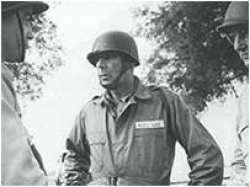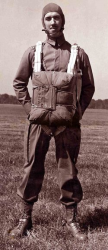
 |
|
|
||
|
William Thomas Ryder 'Bill' |
||||
|
Graduate, U.S. Military Academy, Class of 1936 Engagements: • World War II (1941 - 1945) |
||||
| Biography: | ||||
|
William Thomas "Bill" Ryder William Thomas Ryder was born on 16 April 1913. Ryder graduated from the U.S. Military Academy in 1936. Among his classmates was future Lieutenant General William P. Yarborough, known as the "Father of the Modern Green Berets." After being commissioned a Second Lieutenant of Infantry in the U.S. Army, Ryder later became the first Army paratrooper. More than 200 soldiers volunteered to make up the first platoon of paratroopers. First Lieutenant Ryder was selected through a competitive written exam that was scheduled to take two hours. He finished it in 45 minutes while still earning the top score. The second highest scorer was Lt. James A. Bassett, who thus became the Assistant Platoon Leader. The platoon was billeted at Lawson Army Air Field near Fort Benning, GA. Ryder is credited with creating "Ryder's Death Ride" a 34-foot tower from which trainees practiced jumping. After completing a rigorous conditioning and training program that Ryder had devised, on 16 August 1940, Ryder and ten members of his platoon made their first jump from a Douglas C-33 aircraft. Ryder was the first man to exit the aircraft and the first enlisted man to jump was Pvt. William N. "Red" King. The platoon conducted its first mass jump on 29 August 1940. In April 1943, while assigned as Parachute Training Officer of the Airborne Command at Camp Mackall, NC, Ryder was temporarily assigned as Liaison Officer to the 52nd Troop Carrier Wing at Pope Air Force Base. On 13 July 1943, Ryder jumped into Sicily with Colonel Jim Gavin, commander of the 505th Parachute Infantry Regiment, as part of Operation Husky. After hostilities had ceased in Sicily, Gavin tasked Ryder with returning the personal effects of 1st Battalion Commander Arthur F. Gorham to his widow. Gorham was killed during the first few days of the assault and was credited by Gavin with accomplishing all of the Regiment's objectives. Ryder is also reported, by at least one source, to have jumped with the 509th Parachute Infantry Regiment in North Africa as part of Operation Torch in October 1942. Upon his return from Sicily, Ryder was assigned as the Regimental Commander of the newly-formed 542nd Infantry Regiment at Fort Benning. Expecting to be deployed to Europe, Ryder was instead ordered in December 1943 to provide roughly 100 replacements for the Pacific Theater. As was customary, Ryder escorted the men by train to the West coast. Upon his arrival at Ft. Ord, CA, he was ordered to report to Ft. Benning "first priority." When he returned, he received the disheartening news that he was to dispatch 1,000 of his remaining troops to serve as replacements to airborne units in England preparing for the invasion of Europe. The Regiment was deactivated on 17 March 1944. War and Occupation in the Pacific Following promotion to full Colonel, in mid-February 1944, Ryder was dispatched to Brisbane, Australia, to advise General Douglas MacArthur on airborne operations. He remained a member of MacArthur's staff until President Truman relieved MacArthur in 1951. During the occupation and rebuilding of Japan, Ryder was effectively the Chief of Staff to Major General William F. Marquat. During his time in the Pacific, Ryder met his future wife, Muriel, who was serving with the Red Cross there. In late 1950s and early 1960s, Ryder was the Deputy Chief of the Public Information Division in Paris. By 1963 he was the Director of Special Weapons in the Office of the Chief of Research and Development at the Pentagon. In this last post, he was an expert in guided missile systems. Brigadier General Ryder retired from active duty in 1966 and moved to Pinehurst, NC, with his wife, Muriel. Medals, Awards and Badges Distinguished Service Medal Honors The award given to the most outstanding graduate of the Airborne course at Ft. Benning is named for Brigadier General Ryder. In 1990, Brigadier General Ryder represented the Airborne to receive a proclamation by North Carolina Governor Jim Martin honoring the 50th anniversary of his first jump. In 1995, the officer's golf course at Ft. Bragg, NC, was named for General Ryder. Death and Burial Brigadier General William Thomas Ryder died on 1 October 1992 from cancer. He is buried at Arlington National Cemetery in Arlington, VA. |
||||
| Honoree ID: 3036 | Created by: MHOH | |||
Ribbons
Medals
Badges
Honoree Photos
 |  |  |
 |  |
 |


